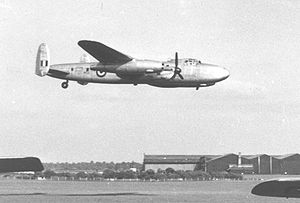Avro Lancastrian Video - Picture

|
|
Avro Lancastrian
Lancastrian

Picture - Avro Nene Lancastrian test-bed demonstrating on its two jets with its Merlins feathered at Coventry Airport in June 1954
Role: Passenger and mail transport
Manufacturer: Avro
Designed by: Roy Chadwick
First flight: 1943
Introduced: 1945 (BOAC)
Retired: 1960
Primary users: BOAC
Trans Canada Airlines
Alitalia
Royal Air Force
Rolls-Royce (engine test-beds)
Produced: 1943-1945
Number built: 91 (including conversions)
Developed from: Avro Lancaster
The Avro 691 Lancastrian was a British passenger and mail transport aircraft of the 1940s and 1950s developed from the Avro Lancaster heavy bomber. The Lancaster was named after Lancaster, Lancashire; a Lancastrian is an inhabitant of Lancashire.
The Lancastrian was basically a modified Lancaster bomber without armour or armament and with the gun turrets replaced by streamlined metal fairings. The initial batch was converted directly from Lancasters; later batches were new builds.
Design and development
In 1943, Avro, through its wartime Victory Aircraft Canadian subsidiary, converted a Lancaster X bomber for civil transport duties with Trans-Canada Airlines (TCA). This conversion was a success resulting in eight additional Lancaster Xs being converted. The "specials" were powered by Packard-built Merlin 38 engines and featured a lengthened, streamlined nose and tail cone. Range was enhanced by two 400 gal (1,818 L) Lancaster long-range fuel tanks fitted as standard in the bomb bay. These Lancastrians were used by TCA on its Montreal-Prestwick route.
The modification of abundant military aircraft into desperately needed civil transports was common in the United Kingdom in the immediate post-war period: the Handley Page Halton was a similar conversion of the Halifax heavy bomber.
Operational history
In 1945, deliveries commenced of 30 British-built Lancastrians for BOAC. On a demonstration flight on 23 April 1945, G-AGLF flew 13,500 mi (21,700 km) from England to Auckland, New Zealand in three days, 14 hours at an average speed of 220 mph (354 km/h).
The Lancastrian was fast, had a long range, and was capable of carrying a heavy load, but space inside was very limited as the Lancaster had been designed with space for its 7 crew dispersed through the fuselage, and the 33 ft (10.05 m) long bomb bay. Consequently it was not suited to carry large numbers of passengers, but for mail and a small number of VIP passengers. BOAC used it for flights between England and Australia from 31 May 1945. It also served with the RAF; RAF Lancaster I number PD328, converted to a Lancastrian and renamed Aries, completed the first airborne circumnavigation of the globe, as well as serving with QANTAS and Flota Aérea Mercante Argentina.
Lancastrians were used during the Berlin Airlift to transport petrol; 15 aircraft made over 5,000 trips.
Two Lancastrian Is were used by Rolls Royce and the Royal Aircraft Establishment for tests of various turboprop and jet engines. One powered by two Rolls-Royce Nene turbojets in addition to two Merlins is credited with the first international passenger jet flight from London to Paris on 23 November 1946; the flight time was 41 minutes on power from the jets alone.
Star Dust

Picture - The B.S.A.A Lancastrian 3, Star Dust
On 2 August 1947 Lancastrian G-AGWH Star Dust of British South American Airways was lost in the Argentine Andes, whilst en route from Buenos Aires, Argentina, to Santiago, Chile. The probable cause of the crash was a navigation error due to the then-unknown effect of the fast-moving jetstream.
Variants
Lancaster XPP Nine built by converting Lancasters at Victory Aircraft Ltd Canada. Lancastrian C.1 Nine-seat transport aircraft for BOAC and Qantas. Royal Air Force designation Lancastrian C.1 to Specification 16/44. A total of 23 built by Avro Lancastrian C.2 Nine-seat military transport aircraft for the RAF. A total of 33 built by Avro Lancastrian 3 13-seat transport aircraft for British South American Airways. A total of 18 built by Avro Lancastrian C.4 Ten to 13-seat military transport aircraft for the RAF. Eight built by Avro
Operators
Civil Operators
Argentina
Flota Aérea Mercante Argentina
Australia
Qantas
Canada
Trans Canada Airlines
Italy
Alitalia
United Kingdom
British European Airways
British Overseas Airways Corporation (BOAC)
British South American Airways
Flight Refuelling Ltd
Silver City
Skyways Limited
Military Operators
Argentina
Argentine Air Force
United Kingdom
Royal Air Force
No. 24 Squadron RAF
No. 231 Squadron RAF
No. 232 Squadron RAF
Specifications (Lancastrian C.1)
Data from
General characteristics
Crew: 5
Capacity: 9 passengers
Payload: mail (3,560 kg)
Length: 76 ft 10 in (23.4 m)
Wingspan: 102 ft (31.1 m)
Height: 19 ft 6 in (5.9 m)
Wing area: 1,297 ft² (120.5 m²)
Empty weight: 30,426 lb (13,800 kg)
Loaded weight: 65,000 lb (29,480 kg)
Powerplant: 4x— Rolls Royce Merlin 12 piston engine, 1,250 hp (930 kW) each
Performance
Maximum speed: 310 mph (500 km/h) at 5,000 ft (1,520 m)
Range: 4,150 mi (6,680 km)
Service ceiling: 23,000 ft (7,000 m)
Rate of climb: 750 ft/min (230 m/min)
Related development
Avro Lancaster
Avro York
Bibliography
Franks, Richard A. The Avro Lancaster, Manchester and Lincoln: A Comprehensive Guide for the Modeller. London: SAM Publications, 2000. ISBN 0-9533465-3-6.
Holmes, Harry. Avro Lancaster (Combat Legend series). Shrewsbury, UK: Airlife Publishing Ltd., 2002. ISBN 1-84037-376-8.
Jackson, A.J. Avro Aircraft since 1908, 2nd edition. London: Putnam Aeronautical Books, 1990. ISBN 0-85177-834-8.
Mackay, R.S.G. Lancaster in action. Carrollton, Texas: Squadron/Signal Publications Inc., 1982. ISBN 0-89747-130-X.
Milberry, Larry. The Canadair North Star. Toronto: CANAV Books, 1982. ISBN 0-07-549965-7.
Ottaway, Susan and Ian. Fly With the Stars - A History of British South American Airways. Andover, Hampshire, UK: Speedman Press, 2007. ISBN 978-0-7509-4448-9.
Taylor, John W. R. "Avro Lancaster." Combat Aircraft of the World from 1909 to the present. New York: G.P. Putnam's Sons, 1969. ISBN 0-425-03633-2.
Avro Lancastrian Pictures and Avro Lancastrian for Sale.
Living Warbirds: The best warbirds DVD series.
Source: WikiPedia